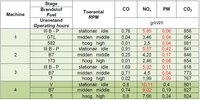SPS CHARTS EMISSIONS FROM POPULAR ENGINES
Due to the increasing debate about emissions from mobile machines and the CO2-free construction site, Smart Platform Solutions B.V. (SPS) recently commissioned an ISO-17025 accredited laboratory to perform emission measurements on two commonly used diesel engines in aerial working platforms. This concerns the indicative determination of carbon monoxide (CO), nitrogen oxides (NOx), (fine) dust in the flue-gases / soot (PM) and carbon dioxide (CO2). It is brought to the attention that it is not a question of engine manufacturers; consequently, the manufacturer names are not reported here.
The engines examined concern three atmospheric breathable 2.9 liter diesel engines (50 kW / 2600 rpm) and a 1.3 liter (18.5 kW / 2600 rpm). Besides functioning as a primary power source, the last mentioned engine is often used in the so-called hybrid machines, which have an environmentally-friendly appearance.
Both the 1.3-liter engine and 1 of the 2.9-liter engines are new and have less than 10 hours on the operating hours counter) and the fuel used is diesel (B7). Also a 2.9 liter engine with +/- 200 operating hours with the same fuel was investigated to find out if the operating hours have any influence. It has also been investigated whether a significant and positive result can be achieved by using GTL (diesel fuel obtained synthetically from natural gas) instead of "normal diesel". This last engine has already been running for 580 hours.
It is underlined here that the measurements do not concern a complete C1 cycle according to ISO 8178. All engines are subject to a fixed test protocol, which means, that a minimum of 10 minutes is measured at "idle", "middle" and "high" speed, according to the machine settings. It should be noted in this regard that all engines were at operating temperature before the measurements were started, so any influences of a cold engine are excluded.
The three machines equipped with the 2.9 liter engines have the year of construction 2016 (GTL), 2017 and 2018 (B7) and therefore subjected to Stage III-B in accordance with European regulations. The machine, equipped with a 1.3-liter engine, was built in 2019 and therefore classified as Stage V.
The standard has thus been established by means of the overview below (the Stage V requirements are also included here as an illustration). It is noted that there is no reference and / or limit value for the CO2 measurement; this value is only illustrative and gives an indication of the CO2 footprint (a calculation of this is shown below the results).
Below is an overview of the measurement results presented, in which any measurement uncertainties have already been corrected:
With regard to CO2 emissions, a calculation example of a machine equipped with the 2.9 liter engine, assuming 200 operating hours per year, this leads to emissions of 8.5 tonnes of CO2 per year.
A number of highlights can be deduced from the above:
> The amount of carbon monoxide (CO) emitted meets all requirements in all measurements.
> The amount of nitrogen oxides (NOx) emitted does not meet the specified limit values for all 2.9-liter engines, and that of the 1.3-liter engine only at high speed. The 1.3 liter engine, in particular with idle and middle speed, shows a considerable excess.
> The amount of dust emitted in the flue gasses (soot; PM) does not meet at any speed with the 2.9 liter engines. The 1.3 liter engine does meet the emission requirements in regard to this topic.
> The difference between a new engine and an engine with about 200 running hours has little or no influence on the amount of nitrogen oxides emitted when using “normal diesel”. With regard to the emission of carbon monoxide, the engine with about 200 running hours scores better compared to the new engine at the three speeds. Reverse results are noticed with regard to the emission of dust; here the new engine performs better at the idle and middle speed, with the high speed showing no clear difference.
> The use of GTL shows a positive result for the emission of carbon monoxide at idle and mid speed. The effect at high speed is not significant. The effect of GTL on nitrogen dioxide emissions cannot be demonstrated by the results of the tests. The emission of dust in the flue gases is considerably reduced when GTL is used, but does not meet the set limit values.
It can be concluded that by the results of this indicative tests, that the stage III B engines in particular show a serious contamination against the previous requirements of Stage III on (fine) dust in the flue-gases. The stage V engine subjected to the test performs better in this section, but again shows an unpleasant result with regard to the emission of nitrogen oxides.
Considering the above, SPS offers the possibility of converting this type of machines to electrically driven. In addition to the positive effect on emissions, electric drive also has a positive effect on the working environment through a strong reduction of the emitted noise. This reduces fatigue and makes communication easier.






